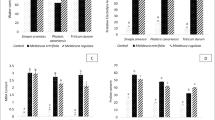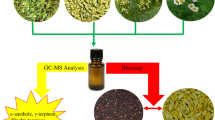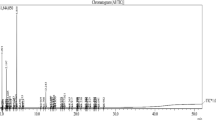Abstract
This work aimed to assess the phytotoxic potential of 12 essential oils (EOs) collected from plants growing in natural or cultivated stands in a temperate climate, i.e., Achillea millefolium, Acorus calamus, Carum carvi, Chamomilla recutita, Foeniculum vulgare, Lavandula angustifolia, Melissa officinalis, Mentha × piperita, Salvia officinalis, Solidago canadensis, Tanacetum vulgare and Thymus vulgaris. The germination of four weed species, i.e., Amaranthus retroflexus, Avena fatua, Bromus secalinus and Centaurea cyanus, was tested against all 12 EOs, and the germination of three crops, i.e., Avena sativa, Brassica napus and Zea mays, was tested in the presence of six EOs. The influence of five doses of each EO against the germination of the tested species was assessed in a petri dish experiment. The results were analyzed using dose-response non-linear analysis, the effective dose (ED50) and multivariate analysis. As a result, four groups of EOs of contrasting phytotoxicity were distinguished. The most phytotoxic group consisted of four EOs, namely C. carvi, T. vulgaris, M. × piperita and S. officinalis. These EOs were composed mainly of oxygenated monoterpenes in a range of 64.1–93.3 %. The least phytotoxic group consisted of S. canadensis EO, composed mainly of mono- and sesquiterpene hydrocarbons (92.3 %). In addition, principal component analysis indicated that the phytotoxic effect of the EOs also depended on the sensitivity of the plant species. Crops are more tolerant than weeds to the majority of EOs. Small-seeded species, namely A. retroflexus and C. cyanus, were the most sensitive to the EOs, while the kernels of Z. mays and the seeds of A. fatua were the most tolerant.


Similar content being viewed by others
References
Abbad A, Kasrati A, Jamali CA, Zeroual S, Ba M’hamed T, Spooner-Hart R, Leach D (2014) Insecticidal properties and chemical composition of essential oils of some aromatic herbs from Morocco. Nat Prod Res 28:2338–2341
Ahuja N, Singh HP, Batish DR, Kohli RK (2015) Eugenol-inhibited root growth in Avena fatua involves ROS-mediated oxidative damage. Pestic Biochem Physiol 118:64–70
Amri I, Hamrouni L, Hanana M, Jamoussi B (2013) Reviews on phytotoxic effects of essential oils and their individual components: news approach for weeds management. Int J Appl Biol Pharmac Technol 4:96–114
Angelini L, Carpanese G, Cioni PL, Morelli I, Macchia M, Flamini G (2003) Essential oils from Mediterranean Lamiaceae as weed germination inhibitor. J Agric Food Chem 51:6158–6164
Araniti F, Lupini A, Mercati F, Statti GA, Abenavoli MR (2013) Calamintha nepeta L. (Savi) as source of phytotoxic compounds: bio-guided fractionation in identifying biological active molecules. Acta Physiol Plant 35:1979–1988
Araniti F, Marrelli M, Lupini A, Mercati F, Statti GA, Abenavoli MR (2014) Phytotoxic activity of Cachrys pungens Jan, a Mediterranean species: separation, identification and quantification of potential allelochemicals. Acta Physiol Plant 36:1071–1083
Azirak S, Karaman S (2008) Allelopathic effect of some essential oils and components on germination of weed species. Acta Agric Scand Sec B Soil Plant Sci 58:88–92
Belhattab R, Amor L, Barroso JG, Pedro LG, Figueiredo AC (2014) Essential oil from Artemisia herba-alba Asso grown wild in Algeria: variability assessment and comparison with an updated literature survey. Arab J Chem 7:243–251
Boz I, Burzo I, Zamfirache MM, Efrose R (2014) Essential oils of Thymus comosus Heuff. ex Griseb. et Schenk (Lamiaceae) collected from different areas of Romania. Analele Stiintifice ale Universitatii “Al. I. Cuza” din Iasi 60:40–45
Buchbauer G (2009) Biological activities of essential oil. In: Baser KHC, Buchbauer G (eds) Handbook of essential oils: science, technology, and applications. CRC Press, Boca Raton, pp 235–280
Burt S (2004) Essential oils: their antibacterial properties and potential application in foods—a review. Int J Food Microbiol 94:223–253
Cavalieri A, Caporali F (2010) Effects of essential oils of cinnamon, lavender and peppermint on germination of Mediterranean weeds. Allelopathy J 25:441–452
Dayan FE, Owens DK, Duke SO (2012) Rationale for a natural products approach to herbicide discovery. Pest Manag Sci 68:519–528
De Almeida LFR, Frei F, Mancini E, De Martino L, De Feo V (2010) Phytotoxic activities of Mediterranean essential oils. Molecules 15:4309–4323
De Martino L, Mancini E, de Almeida LFR, De Feo V (2010) The antigerminative activity of twenty-seven monoterpenes. Molecules 15:6630–6637
De Martino L, Mancini E, Marandino A, de Almeida LFR, De Feo V (2012) Chemistry and antigerminative activity of essential oils and monoterpenoids from Mediterranean plants. Curr Bioactive Compd 8:13–49
Dudai N, Poljakoff-Mayber A, Mayer AM, Putievsky E, Lerner HR (1999) Essential oils as allelochemicals and their potential use as bioherbicides. J Chem Ecol 25:1079–1089
Duke SO, Dayan FE, Rimando AM, Schrader KK, Aliotta G, Oliva A, Romagni JG (2002) Chemicals from nature for weed management. Weed Sci 50:138–151
Fichan I, Larroche C, Gros JB (1999) Water solubility, vapor pressure, and activity coefficients of terpenes and terpenoids. Chem Eng Data 44:56–62
Gilani SA, Fujii Y, Shinwari ZK, Adnan M, Kikuchi A, Watanabe KN (2010) Phytotoxic studies of medicinal plant species of Pakistan. Pak J Bot 42:987–996
Isman MB (2000) Plant essential oils for pest and disease management. Crop Prot 19:603–608
Isman MB, Miresmailli S, Machial C (2011) Commercial opportunities for pesticides based on plant essential oils in agriculture, industry and consumer products. Phytochem Rev 10:197–204
Kalemba D, Kunicka A (2003) Antibacterial and antifungal properties of essential oils. Curr Med Chem 10:813–829
Kaur S, Singh HP, Mittal S, Batish DR, Kohli RK (2010) Phytotoxic effects of volatile oil from Artemisia scoparia against weeds and its possible use as a bioherbicide. Ind Crops Prod 32:54–61
Knezevic SZ, Streibig JC, Ritz C (2007) Utilizing R software package for dose-response studies: the concept and data analysis. Weed Technol 21:840–848
Kolb RM, Pilon NAL, Durigan G (2016) Factors influencing seed germination in Cerrado grasses. Acta Bot Bras 30:87–92
Kong C, Hu F, Xu T, Lu Y (1999) Allelopathic potential and chemical constituents of volatile oil from Ageratum conyzoides. J Chem Ecol 25:2347–2355
Kozak M, Bocianowski J, Sakwojć S, Wnuk A (2010) Call for more graphical elements in statistical teaching and consultancy. Biom Lett 47:57–68
Kpoviessi DSS, Gbenou JD, Gbaguidi FA, Ahoussi L, Accrombessi GC, Moudachirou M, Quetin-Leclercq J (2009) Justicia anselliana (Nees) T. Anders essential oils compounds and allelopathic effects on cowpea Vigna unguiculata (L.) walp plant. J Essent Oil Res 21:83–88
Kumar V, Mathela CS, Tewari AK, Bisht KS (2014) In vitro inhibition activity of essential oils from some Lamiaceae species against phytopathogenic fungi. Pest Biochem Physiol 114:67–71
López ML, Bonzani NE, Zygadlo JA (2009) Allelopathic potential of Tagetes minuta terpenes by a chemical, anatomical and phytotoxic approach. Biochem Syst Ecol 36:882–890
Mancini E, Camele I, Elshafie HS, De Martino L, Pellegrino C, Grulova D, De Feo V (2014) Chemical composition and biological activity of the essential oil of Origanum vulgare ssp. hirtum from different areas in the Southern Apennines (Italy). Chem Biodiv 11:639–651
Marichali A, Hosni K, Dallali S, Ouerghemmi S, Hadjltaief HB, Benzarti S, Kerkeni A, Sebei H (2014) Allelopathic effects of Carum carvi L. essential oil on germination of wheat, maize, flax and canary grass. Allelopathy J 34:81–94
Martínez-Natarén DA, Parra-Tabla V, Ferrer-Ortega MM, Calvo-Irabién LM (2014) Genetic diversity and genetic structure in wild populations of Mexican oregano (Lippia graveolens HBK) and its relationship with the chemical composition of the essential oil. Plant Syst Evol 300:535–547
Moreno JL, Garcıa C, Landi L, Falchini L, Pietramellara G, Nannipieri P (2001) The ecological dose value (ED50) for assessing Cd toxicity on ATP content and dehydrogenase and urease activities of soil. Soil Biol Biochem 33:483–489
Morrison DF (1976) Multivariate statistical methods, 2nd edn. Mc Graw-Hill Kogakusha, Tokio
Mutlu S, Atici Ö, Esim N (2010) Bioherbicidal effects of essential oils of Nepeta meyeri Benth. on weed spp. Allelopathy J 26:291–300
Penny KI (1996) Appropriate critical values when testing for a single multivariate outlier by using the Mahalanobis distance. Appl Stat 46:73–81
Perricone M, Arace E, Corbo MR, Sinigaglia M, Bevilacqua A (2015) Bioactivity of essential oils: a review on their interaction with food components. Front Microbiol. doi:10.3389/fmicb.2015.00076
Poonpaiboonpipat T, Pangnakorn U, Suvunnamek U, Teerarak M, Charoenying P, Laosinwattana C (2013) Phytotoxic effects of essential oil from Cymbopogon citratus and its physiological mechanisms on barnyardgrass (Echinochloa crus-galli). Ind Crops Prod 41:403–407
Ritz C, Streibig JC (2005) Dose response curves and other nonlinear curves in weed science and ecotoxicology with the add-on package drc in R. http://www.bioassay.dk/index-filer/start/DraftDrcManual.pdf. 2012
Rolli E, Marieschi M, Maietti S, Sacchetti G, Bruni R (2014) Comparative phytotoxicity of 25 essential oils on pre-and post-emergence development of Solanum lycopersicum L.: a multivariate approach. Ind Crops Prod 60:280–290
Saad MMG, Abdelgaleil SAM, Suganuma T (2012) Herbicidal potential of pseudoguaninolide sesquiterpenes on wild oat, Avena fatua L. Biochem Syst Ecol 44:333–337
Stokłosa A, Matraszek R, Isman M, Upadhyaya MK (2012) Phytotoxic activity of clove oil, its constituents, and its modification by light intensity in broccoli and common lambsquarters (Chenopodium album). Weed Sci 60:607–611
Stolarska A, Wieczorek A (2015) The effect of some essential oils on adenine nucleotide levels and activity of oxidative stress enzymes in caraway (Carum carvi L.). J Essent Oil Res 27:343–354
Thompson JD, Chalchat JC, Michet A, Linhart YB, Ehlers B (2003) Qualitative and quantitative variation in monoterpene co-occurrence and composition in the essential oil of Thymus vulgaris chemotypes. J Chem Ecol 29:859–880
Tursun N, Karci A, Alma MH, Seyithanoglu M (2006) Bio-herbicidal effects of thyme oil and carvacrol on different weed and crop species. Proceedings of the Annual International Research Conference on Methyl Bromide Alternatives and Emissions Reductions. 6–9 Nov 2006. Orlando, FL, http://www.crec.ifas.ufl.edu/extension/soilipm/2006MBAO/Tursun,%20Nihat/Tursun,%20Nihat%20(135)%202006%20Presentation.pdf
Tzakou O, Gani A, Economou G, Yannitsaros A (2011) Chemical composition and allelopathic activity of oil and volatile fractions of Conyza albida Willd. ex Sprengel from Greece. J Essent Oil Res 16:425–428
Vasilakoglou I, Dhima K, Paschalidis K, Ritzoulis C (2013) Herbicidal potential on Lolium rigidum of nineteen major essential oil components and their synergy. J Essent Oil Res 25:1–10
Vaughn SF, Spencer GF (1993) Volatile monoterpenes as potential parent structure for new herbicides. Weed Sci 41:114–119
Verdeguer M, Blázquez MA, Boira H (2009) Phytotoxic effects of Lantana camara, Eucalyptus camaldulensis and Eriocephalus africanus essential oils in weeds of Mediterranean summer crops. Biochem Syst Ecol 37:362–369
Vokou D (1999) Essential oils as allelochemicals: research advances in Greece. In: Narwal SS (ed) Allelopathy Update (Vol 2) Basic and Applied Aspects. Science, New York, pp 47–63
Vokou D, Douvli P, Blionis GJ, Halley JM (2003) Effects of monoterpenoids, acting alone or in pairs, on seed germination and subsequent seedling growth. J Chem Ecol 29:2281–2301
Weyerstahl P, Marschall H, Christiansen C, Kalemba D, Góra J (1993) Constituents of the essential oil of Solidago canadensis (Goldenrod) from Poland—a correction. Planta Med 59:281–282
Authors contribution
A.S. conceived, designed and conducted the research. E.D. and D.K. hydrodistilled the essential oils, and D.K. analyzed the chemical composition of the essential oils. J.B. and A.S. analyzed the data. A.S. and D.K. wrote the manuscript. All authors read and approved the manuscript.
Funding
This research was funded by the Ministry of Science and Higher Education of the Republic of Poland (DS 3124).
Author information
Authors and Affiliations
Corresponding author
Ethics declarations
Conflict of interest
A. Synowiec declares that she has no conflict of interest. D. Kalemba declares that she has no conflict of interest. E. Drozdek declares that she has no conflict of interest. J. Bocianowski declares that he has no conflict of interest.
Ethical approval
This article does not contain any studies with human participants or animals performed by any of the authors.
Additional information
Communicated by M. B. Isman.
Electronic supplementary material
Below is the link to the electronic supplementary material.
Rights and permissions
About this article
Cite this article
Synowiec, A., Kalemba, D., Drozdek, E. et al. Phytotoxic potential of essential oils from temperate climate plants against the germination of selected weeds and crops. J Pest Sci 90, 407–419 (2017). https://doi.org/10.1007/s10340-016-0759-2
Received:
Revised:
Accepted:
Published:
Issue Date:
DOI: https://doi.org/10.1007/s10340-016-0759-2




